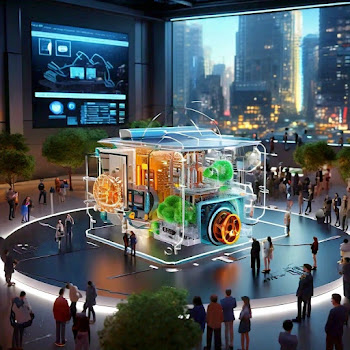Introduction:
Nanotechnology, the manipulation of matter on a molecular and atomic scale, has revolutionized various fields, from medicine to energy production. This innovative technology has the potential to transform our world, addressing pressing global challenges like climate change, resource depletion, and healthcare. The term "nano" refers to the incredibly small scale of nanotechnology, with nanoparticles measuring between 1 and 100 nanometers in size. To put this into perspective, human hair is approximately 80,000 nanometers thick!
Nanotechnology has already made significant contributions to various industries, including electronics, energy, and healthcare. Its applications are vast and diverse, ranging from improved energy storage and conversion to targeted drug delivery and medical diagnostics. As the world grapples with the challenges of sustainability, nanotechnology offers promising solutions to reduce our environmental footprint and create a more sustainable future.
In this article, we will explore the future of nanotechnology, its applications, and its role in promoting sustainability. We will examine the benefits and challenges of nanotechnology and discuss its potential to address global challenges and create a better future for generations to come.
Applications of nanotechnology:
Nanotechnology has the potential to transform various industries and aspects of our lives. Some of the most significant applications of nanotechnology include:
- Energy production and storage:
Nanotechnology has improved energy production and storage efficiency. Nanostructured materials enhance solar panel performance, while nanomaterial-based batteries store more energy and charge faster. This increases the adoption of renewable energy sources, reducing greenhouse gas emissions, and mitigating climate change.
- Water purification and management:
Nanotechnology helps remove contaminants and pollutants from water, making it potable. Nanostructured membranes and nanomaterial-based systems improve water treatment efficiency, addressing global water scarcity.
- Healthcare and Medicine:
Nanotechnology has led to breakthroughs in drug delivery, diagnostics, and tissue engineering. Nanoparticles transport drugs to specific cells, reducing side effects. Nanosensors detect diseases at the molecular level, enabling early diagnosis and treatment.
- Agriculture and food production:
Nanotechnology enhances crop yields, disease resistance, and water efficiency. Nanoparticles deliver nutrients and pesticides precisely, reducing waste and environmental impact.
- Environmental Remediation:
Nanotechnology helps clean pollutants from soil, air, and water. Nanomaterials degrade toxic chemicals, restoring ecosystems and promoting sustainability.
These applications demonstrate the vast potential of nanotechnology to address global challenges and create a sustainable future. By harnessing the power of nanotechnology, we can reduce our environmental footprint, improve healthcare, and create innovative solutions for energy and agriculture.
Sustainability and nanotechnology:
Nanotechnology offers numerous sustainable solutions, including:
- Reduced material consumption:
Nanotechnology uses minimal materials, reducing waste and conserving resources. This approach enables the production of sustainable materials, reducing environmental impact.
- Energy Efficiency:
Nanotechnology improves energy production and storage, decreasing energy consumption. This leads to reduced greenhouse gas emissions, mitigating climate change.
- Environmental Remediation:
Nanotechnology cleans pollutants, restores ecosystems, and promotes sustainability. Nanomaterials degrade toxic chemicals, revitalizing contaminated soil and water.
- Water Conservation:
Nanotechnology improves water treatment and management, addressing global water scarcity. Nanostructured membranes and nanomaterial-based systems enhance water purification efficiency.
- Climate change mitigation:
Nanotechnology reduces greenhouse gas emissions, contributing to climate change mitigation. Nanostructured materials and nanomaterial-based systems improve energy efficiency, reducing the carbon footprint.
Nanotechnology integrates with sustainable development, offering innovative solutions for energy, water, and environmental management. By harnessing nanotechnology, we can create a sustainable future, address global challenges, and promote environmental stewardship.
Challenges and Future Directions:
While nanotechnology holds immense potential, challenges persist:
- Scalability:
Large-scale production of nanomaterials is difficult, hindering widespread adoption.
- Toxicity:
Nanoparticles' environmental impact is still unknown, raising concerns about toxicity and safety.
- Regulation:
Lack of standard regulations hinders innovation, creating uncertainty for industries and researchers.
- Public awareness and education:
Limited understanding of nanotechnology among the general public and policymakers slows progress.
- Investment in Research and Development:
Insufficient funding for research and development limits the exploration of nanotechnology's full potential.
Future directions include:
- Interdisciplinary Research:
Collaboration between scientists, engineers, and policymakers is crucial for addressing challenges and unlocking nanotechnology's full potential.
- Investment in Infrastructure:
Developing large-scale production facilities and research centers will accelerate innovation and adoption.
- Public awareness and education:
Promoting understanding and addressing concerns through education and outreach will increase support and investment.
- Regulatory Frameworks:
Establishing standard regulations for nanotechnology development and application will provide clarity and confidence for industries and researchers.
- International Collaboration:
Global cooperation to address shared challenges and promote sustainable development will accelerate progress and impact.
By addressing these challenges and investing in research and development, we can unlock nanotechnology's full potential and create a sustainable future for generations to come.
Benefits of Nanotechnology:
Nanotechnology offers numerous benefits, including:
- Improved Energy Efficiency:
Nanotechnology enhances energy production and storage, reducing energy consumption and greenhouse gas emissions.
- Enhanced Water Management:
Nanotechnology improves water treatment and management, addressing global water scarcity and promoting sustainable development.
- Advanced Healthcare Solutions:
Nanotechnology leads to breakthroughs in drug delivery, diagnostics, and tissue engineering, improving healthcare outcomes and quality of life.
- Sustainable Agriculture Practices:
Nanotechnology enhances crop yields, disease resistance, and water efficiency, promoting sustainable agriculture and reducing environmental impact.
- Environmental Remediation:
Nanotechnology cleans pollutants, restores ecosystems, and promotes sustainability.
- Reduced material consumption:
Nanotechnology uses minimal materials, reducing waste and conserving resources.
- Improved Quality of Life:
Nanotechnology improves healthcare, energy, water, and agriculture, enhancing the overall quality of life.
- Economic Growth:
Nanotechnology creates new industries, jobs, and opportunities, driving economic growth and development.
- International Cooperation:
Global cooperation is facilitated by nanotechnology as it tackles common challenges and advances sustainable development.
We can build a sustainable future by utilizing nanotechnology to solve global issues, encourage environmental stewardship, foster economic growth, and enhance people's quality of life.
Conclusion:
Nanotechnology has the potential to revolutionize our world, address pressing global challenges, and create a sustainable future. From improving energy efficiency and water management to advancing healthcare and agriculture, nanotechnology offers numerous benefits that can transform our lives and our planet.
While challenges persist, the potential rewards of nanotechnology are too great to ignore. By investing in research and development, promoting public awareness and education, and establishing regulatory frameworks, we can unlock nanotechnology's full potential and create a better future for generations to come.
As we look to the future, it is clear that nanotechnology will play a vital role in shaping our world. Let us embrace this technology and its potential, working together to create a sustainable, equitable, and prosperous future for all.
Final Thoughts:
Nanotechnology is a powerful tool, offering solutions to some of humanity's most pressing challenges. Let us harness its potential, working together to create a brighter future for our planet and its inhabitants.








